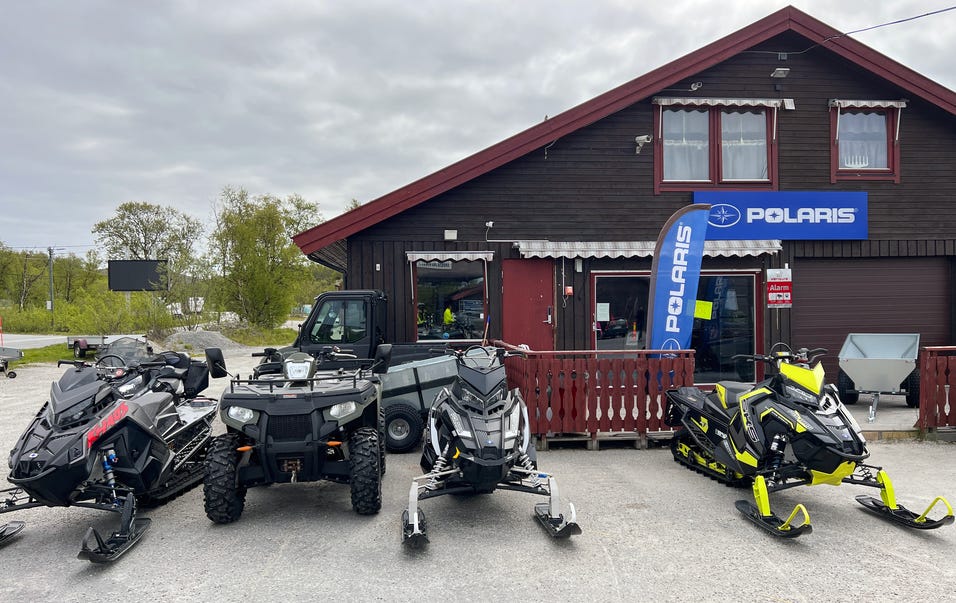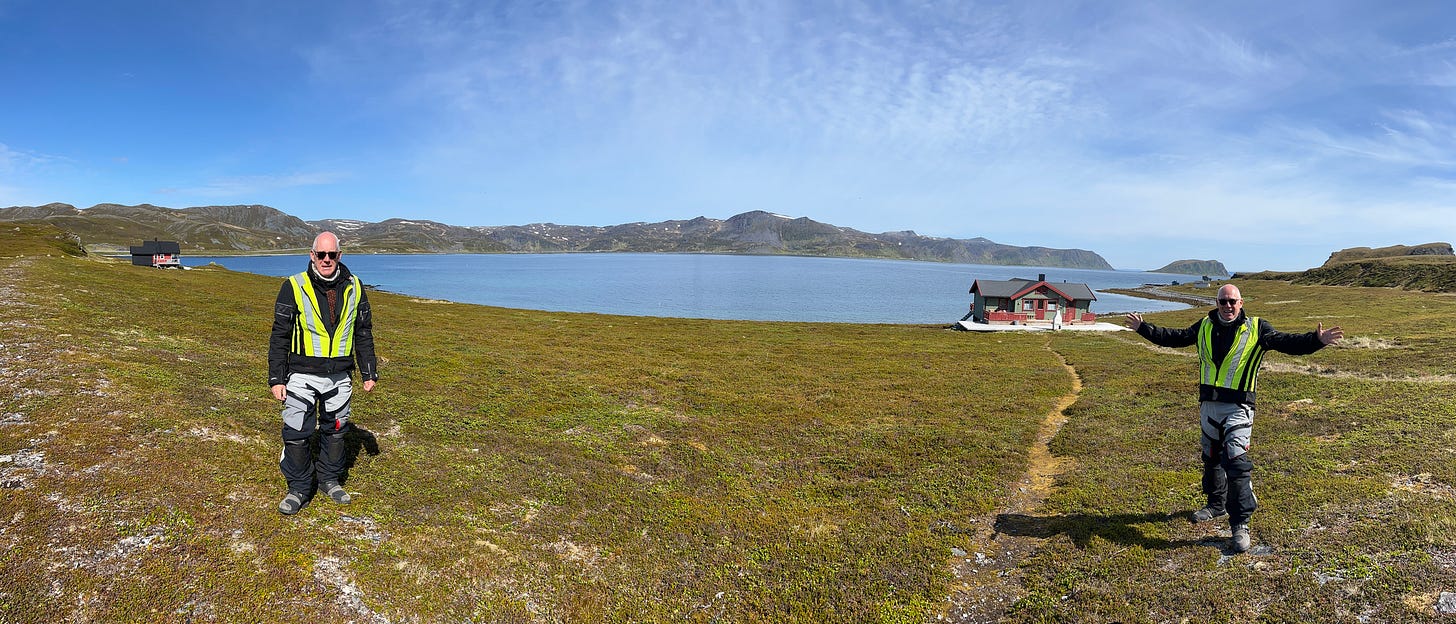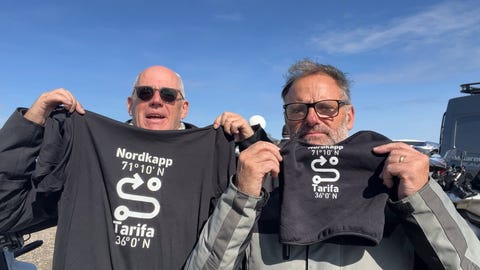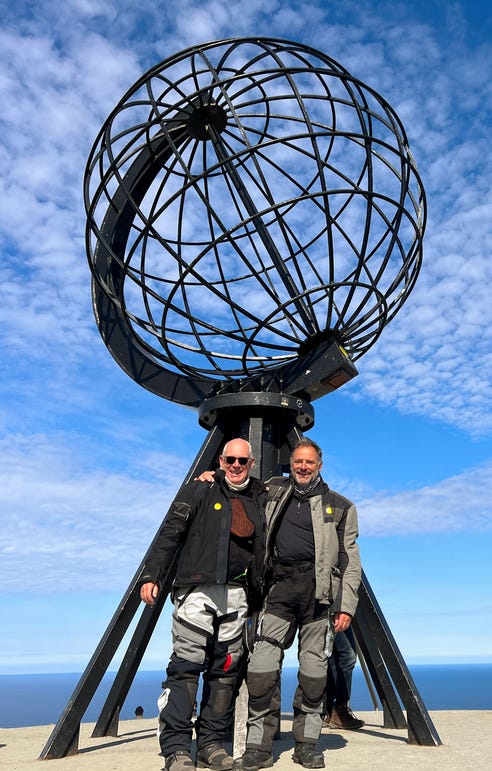It's Nordkapp Day
Will our intrepid duo make it to the most Northerly Point of Mainland Europe?
Looking suitably rugged with several week’s growth of beard and wearing a highly visible, dazzlingly yellow jacket and white helmet, my travelling companion stood outside the verandah of our wooden camping hut.
“The sherpas are briefed, the oxygen tanks are in place, the heavy lifting’s been done and I think we can head off.”
With these immortal words Ralph issued the command to begin the final push to Nordkapp from Alta.
As exploration quotations go, it’s not quite up there with “I am just going outside and may be some time1”, but stirring nonetheless. Ralph was clearly feeling in a heroic mood this morning, fuelled probably by the first decent breakfast we’d had in days.
For once there wasn’t really any route navigation decision to be made. Options were limited to one road, the E6 all the way to Olderfjord, where we’d hang a left directly northwards. From that point onwards to Nordkapp it would be an out-and-back road along the side of the enormous Porsangerfjord, which empties out into the Barents Sea. We had 239 km of riding in prospect to reach Nordkapp before we doubled back and headed southwards for the first time on the trip, to Lakselv, our overnight stop. The weather gods had aligned and the day started brightly. This northern edge of Europe is notorious for wraiths of sea-mist that can float in at any time of the year, so we were delighted that it promised sun, albeit cool temperatures.
On Saturday 17th June 2023, just a few days short of the summer solstice, we ambled across stunning moorland scenery, through valleys and past long mountain ranges like the Cairngorms on steroids. Yet there was very little traffic apart from fellow pilgrims on motorbikes, one or two of whom we recognised from elsewhere. Some were in cars or campervans and - most heroically - on cycles. North of Olderfjord everyone was on a mission and those who’d taken the Sweden-Finland route converged with the Norwegian contingent in a race to the (almost) Pole.
The riding was relaxed, ever mindful of speed cameras. We passed through small towns and hamlets. Always that question, ‘what do they do here in winter when it’s always stygian dark?’ Telegraph poles with endless wires and fast-flowing streams accompanied our travels; with streaks of snow bordering the road and through cuttings we rode; over simple steel bridges across boulder-strewn crashing rivers, brown peaty waters flecked with foam. Into a petrol station for the first of several fill-ups this day. Not a place to run dry, even though we had a little spare can squirrelled away. The garage forecourt? No car dealers here. This was snowmobile territory. In serried ranks they awaited both buyers and winter.
Few trees here, those that grew at all grew small, bent against the wind. A tunnel, long, new-ish and noisy. Emerging from it, on our right the sea, a fjord, still salt-laden air and the odd whiff of kelp. The road, sticking firmly to the coastal contours as if on topographical rails. As the morning wears on the clouds, wispy and low on departure, have burned off and now the sky is azure, the sea a deeper rich hue of the canopy above. The temperature rises, not Mediterranean, but not typical for North Cape, either. In fact, we later meet a silversmith, who says it is like this on only ten days a year, if lucky. We are.
“Last week, two motorcyclists were blown off the road and camper vans overturned, it was that windy,” he says.
We feel very blessed.
No trees at all now, just an uncompromising tundra, brown moss and grass, dotted with small lakes. And then abruptly we plunge into another huge tunnel which leads to Magerøya, the island that is technically part of the mainland and on which sits Nordkapp, hence the eponymous Nordkapptunnelen. It’s nearly 7 kilometres long and reaches nearly 700 feet below sea level. We pull off the road for a rest. We have all the time in the world today and it’s a day to be savoured. We wander across the hard, brown and green tundra with its sedges, mosses and lichens, a path meandering in front of us to a large cabin by the fjord. Surely an idyllic spot for some lucky person.
The road becomes hillier near Honningsvåg, the tiny gateway to Nordkapp, through where all must pass, including the cruise ship hordes. We would have stayed the night here but changed our plans to get closer to Kirkenes and avoid a monster day tomorrow. Besides, we wanted to selfishly savour our eventual triumph, not to share it with those whose ticket has bought it - though to the cyclists we would doff our crash helmets in admiration. The road wound its way upwards with grace and fervour, there was an irresistible impulse pushing us on now. The vistas opened up over the sea. There, surely, that was the Barents Sea and Nordkapp in the distance, a speck now but those buildings must be it. Steep cliffs dropped away on the right. Then, suddenly, round a bend, two kiosks. Halt!
We have reached Nordkapp. Or at least, the commercial arm of it, for unless you wait until late in the evening entry is by ticket only. 310 NOK. Who is going to refuse and turn round? We pay, get our official yellow sticky label badges and crunch our way on to the gravel parking lot alongside a miscellany of other bikes from different nations, all having arrived in this place at this time, their own journeys and adventures complete, at least for now.
Ralph and I embrace. This is the moment we have worked towards. He has a speech ready:
“Rydym wedi cyrraedd ym Nordkapp. Mae wedi bod yn daith hir, yn daith anodd, ond rydym yn hapus i fod yma”.2
Did I tell you he speaks Welsh?
I hand him a souvenir snood; he’s now an honorary member of the Tarifa-Nordkapp club. I dig out the t-shirt celebrating the trip and made months before by my daughter, in anticipation of today. Momentarily, I recall how a hotel yard entrance in Oslo might have curtailed this adventure had I not had good fortune (below).
And I think how fortunate we’ve been to have this adventure at all. The means to do it, both time and money; the wonderful machines we’ve ridden - my Honda NT1100 and Ralph’s BMW RS1250; and the support of our wives who’ve let us out to play.
I mumble something back in Norwegian in reply.
“Aner ikke hva du snakker om, men gratulerer uansett.”3
We wander up to the headland plateau where the iconic globe overlooks the 307 metre high cliffs that plunge into the sea. Next stop that way is the Arctic ice and the North Pole. Even though we’re at 71°10′21″N 25°47′04″E (further east than Istanbul and St Petersburg!), it’s still 2,102 km away from the North Pole. But, without getting our feet wet, this is the end of our progress northwards. It’s all down south from here. We are the most northerly people in Europe right this moment. Everyone’s a southerner to us. Except for anyone who happens to be at Knivkjellodden, which is actually a kilometre further north but a 8 or 9 hour trek away (no roads), which seems improbable. Blame French King Louis XVIII. He obviously couldn’t be bothered with the extra distance when he was an early visitor in 1795. He was likely shagged out. As the Norwegian tourist website (nordnorge.com) coyly puts it: ‘he left genetic traces amongst the people of Finnmark’.
Ralph and I waited for our moment of glory under the globe, grabbed a selfie courtesy of some other pilgrims and then wandered off round the headland to see the ‘Children of the World’ sculpture and its accompanying Mother and Child statues. We reflected on all the places we’d been to and the people we’d met. It was, we agreed, a cracking adventure, an epic and - despite the assertions of Klaus the lugubrious Dutchman we’d encountered at Andenes - it was well worth the effort.
Once we’d breathed in enough of the freshest possible northern air, taken our fill of the astonishing sunshine and walked our bike-seized legs to a state of pleasant tiredness, it was time to grab some souvenirs, especially the prized pannier stickers, refuel our stomachs for the long stretch ahead and then head - reluctantly and with long, lingering glances back towards the globe - to our bikes and homeward bound.
The last words of Captain Oates in the Antarctic, as he left Scott’s tent for the last time in 1912, Team Britain having lost to Norway the race to the South Pole.
‘We have arrived in Nordkapp. It’s been a long journey, a difficult journey, but we are happy to be here.’
Go on, Google it.












Fantastic journey. Very proud of you and you’re adventures!
An epic journey. Congratulations to both of you.